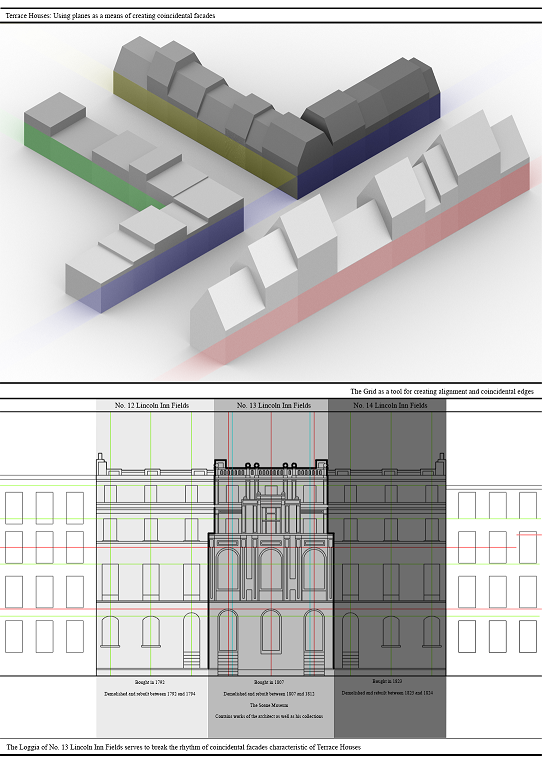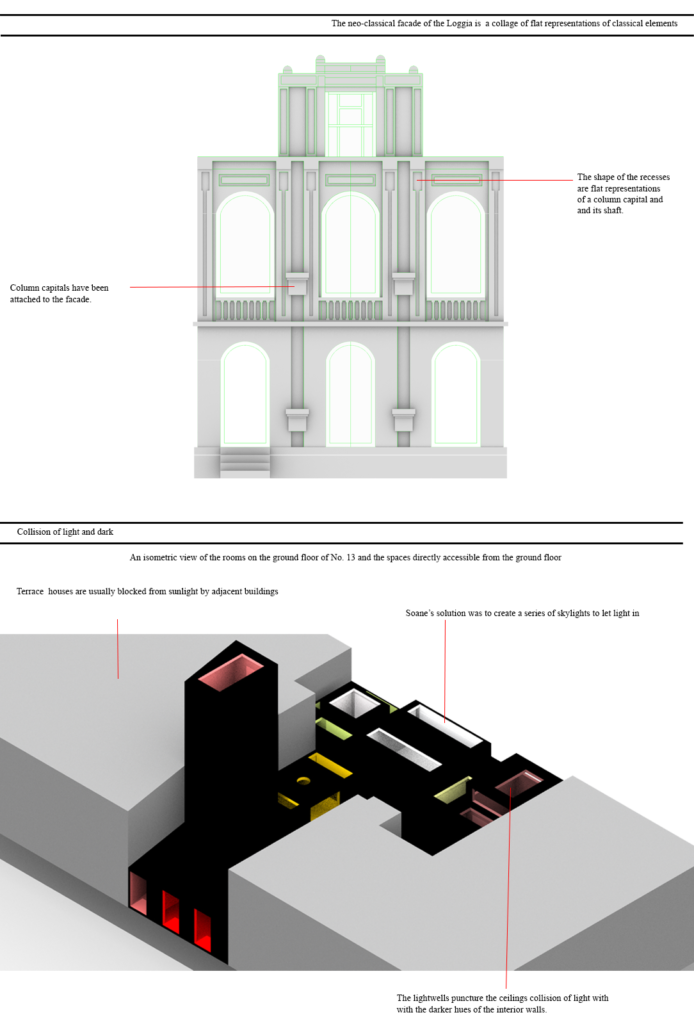Soane’s collections were initially central to Soane’s Vision of creating an Architectural dynasty (Clark, p.8). Dynasty is about continuity and defying the seemingly ultimate nature of death; preserving one’s legacy from the grave. Soane’s eldest son however did not take up after his father. To prevent his sons from inheriting his house and collections he made it a museum through an act of parliament (Clark, p.9). This act, I think memorialized Soane’s ambition. Memorials are not really all about continuity. To memorialize is to recognize the death of something. In this case it was Soane’s initial vision. This context sets the stage for the collision
of two contrasting ideas: Life and death; Continuity and Memorialization.
References
Clark, Kate. Sir John Soane’s Museum. London: Kate Clark Associates, 2008.
For the definitions, the following thoughts come to mind:
Collision: a contrasting mixing of things
Collage: an image or impression formed from multiple parts or elements
Coincidence: the alignment of the whole or parts of ideas, things etc




BERLIN MEMORIAL
- Architect – Peter Eisenmann
- Engineer
- Buro Happold
- Specs
- Total area
- 200,000 sq ft
- 19,000 sq m
- Concrete slabs
- 2,711 concrete slabs or stelae
- The original plan was to place nearly 4,000 slabs, but before the unveiling a new law was passed mandating memorials to be wheelchair accessible.
- Dimensions
- Spacing
- 95 centimeters wide, 2.375 meters long
- Heights
- 0 to 4 meters
- Spacing
- 95 centimeters
- Total area
- Context
- Collision
- 2nd law of thermodynamics
- Disorder increases over time – does not reverse
- History of jewish persecution versus failure of the weimar republic and rise of extreme nationalism – Collision course of separate developments.
- Order and Disorder
- From architect’s site
- ”When a supposedly rational and ordered system grows too large and out of proportion to its intended purpose, it loses touch with human reason. It then begins to reveal the innate disturbances and potential for chaos in all systems of apparent order.”
- The Nazi Machine
- The Nazi machine was so efficient and clever that it managed to separate its individual operations to an extent where the people who were involved in running the monstrous machine could not see its externalities –
- everybody did their part, and few directly experienced the horrors;
- therefore the operators of the machine remained detached from the true product of their labour
- The machine went on running smoothly
- Only from a distance, only through someone looking from the outside in, could you see the devastation
- The Nazi Machine and the Project’s grid layout
- Within the memorial everything looks okay, the ground rises and falls but you still see a way out – the blocks look orderly placed , one after the order.
- When you step outside however, you see the layout is not so orderly
- There is significant variation in height,
- Although the same grid dimensions is used throughout, the edges start to fray, as there are fewer blocks towards the end,
- Also from above, you see the site is not orthogonal
- The idea of silence and noise
- From architect’s site
- 2nd law of thermodynamics
- Collision
- Spacing of the blocks
- Only 95 centimeters spaced
- Allows for mostly only individual passage
- At intersections, people will need to navigate their surroundings consciously to avoid collisions
- Collage
- Definition: when something is formed from discernible parts
- A collage of multiple grid systems
- The project on the whole acknowledges 3 grid system
- 1.The street grid
- 2.The grid for the stelae
- 3.The grid for the subterranean chamber
- These grids don’t align with each other – little or no coincidence (investigate)
- Idea
- The star of david
- Three sets of parallel lines
- Form a whole
- The star of david
- Idea
- The project on the whole acknowledges 3 grid system
- A topographic collage
- The topograph of the stelae heights
- The topography of the floor
- What is the relationship?
- The topographic map as a collage – different heights – if the heights are color-coded – they resemble a collage
- Coincidences and collision
- The grid: As a tool of ensuring coincidence
- But the idea of order and disorder
- Not all surfaces are coincidental some are actual tilted
- Disorder as ultimately been dominant over Order
- If you have a perfect grid, and then you adjust the spacing for just one row – It immediately becomes disordered- a single instance of disorder even in an almost perfect system, renders the whole system disordered.
- On the order hand, a single instance of order in an already disordered system gets lost in a disordered system .
- Coincidences with the Nazi regime – The Nazis sought to create an ”idyllic” ”orderly” system, they decided to do away with disorder (diversity in race, religion etc), but ultimately you can never a create an ”orderly system” from that.
- As the grid approaches the site, the two topographies (of the stelae height and the ground) become closer and closer as the blocks become almost coincidental with the streets on all four sides.
- The wave nature of the stelea field smoothens out as it reaches the street- avoiding a collision with the surrounding and being coincidental the surfaces of the streets on all sides
- Coincidences
- Cemeteries
- Stelae resembles tomb stones
- Dead Jews
- But unusually larger tombstones – mounds of dead jews
- Cemeteries
THE SPATIAL CITY
- A spatial City
- Yona Friedman
- Collage
- The city as a collage created from multiple overlays
- Multiple cities
- Endless expansion
- Collage of multiple grid systems and space frames
- Space frames and grids also allow for variety- but a sort of restricted variety.
- Coincidence
- The grid as a tool for enforcing order and coincidence
- Collision
- ”Spatial”- the aim is avoid collision between the old city and the new city.
- The only way is to build up.
- Do the planes collide??
- Would the new city collide with the old in other aspects?
- ”Spatial”- the aim is avoid collision between the old city and the new city.

